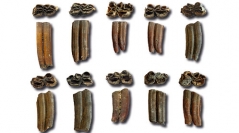

 Geodiversitas
40 (8) - Pages 171-182
Geodiversitas
40 (8) - Pages 171-182The review of lac Karâr equids, which mainly consist of dental remains, show that they (mostly) very likely correspond to wild asses (Equus africanus Heuglin & Fitzinger, 1866) as this was referred to in the summarized work of Churcher & Richardson (1978) and by contrast to the study of Boule (1900) where whole of the remains were attributed to the fossil zebra species Equus mauritanicus Pomel, 1897. This work puts the still poorly understood origin of asses in Africa in spotlight. Most of the clearly identified asses of, at least, the Maghreb (Equus atlanticus Thomas, 1884; Equus melkiensis Bagtache, Hadjouis & Eisenmann, 1984) known as the Atlas wild ass, in fact, derive from upper Pleistocene or more recent sites (Romer 1928, 1935; Churcher & Richardson 1978; Bagtache & Hadjouis 1983; Bagtache et al. 1984; Eisenmann 1986, 1995; Zouhri et al. 1997) whereas lac Karâr is one of the uncommon potentially middle Pleistocene deposits where enough dental remains that possibly belong to this species are recognized, hence the importance of conducting a bimolecular and a radioactive study of this material. Lower Pleistocene deposits are symbolized by a single and not clearly identified species Equus tabeti Arambourg, 1970 that can have phylogenetic relationships with Atlas wild ass (Hadjouis & Le Bihan 2013). Thus, the asinian equid of lac karâr may well represent the previously unknown missing link between lower and upper Pleistocene species. Finally, the species Equus mauritanicus is possibly present with certainty in only two cases of lower intermediate molars.
Perissodactyla, Northern Africa, Algeria, lac Karâr, equids, wild ass